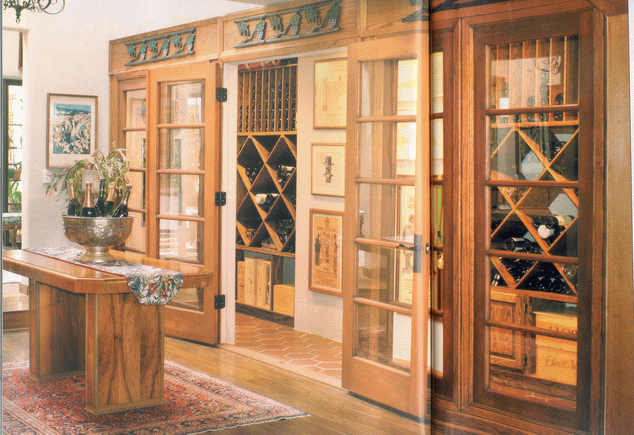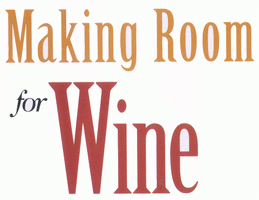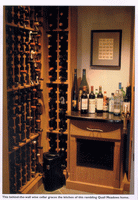

By Melanie Bellon Chatfield
Photography By Kelli Uldall
Carmel Magazine, Winter 2004
As our European brothers and sisters have done for centuries, greater numbers of Americans are incorporating wine into their meals, their rituals and their decors. As one's knowledge of and appreciation for the fruits of the vine increases, often so does one's propensity to gather greater quantities of it. And that means having somewhere to store it properly.
Today, in-home wine storage options are as plentiful and distinct as the wines that call them home - some for short periods, others for decades. Wine storage, also called wine cellaring, is often included in the designs for new homes and remodeling projects. An in-home wine cellar doesn't have to be a literal cellar, it can be virtually anywhere-a cabinet, a closet, a room, yes even a cellar - where wine is stored for future use. Built-in, added on or slipped under, wine storage can be as decorative as it is functional.
Having been in the wine business for nearly two decades, Ken Rauh, of A taste of Monterey on Cannery and in Old Town Salinas, knows a thing or two about storing wine. Ken breaks "wine cellaring" into three major categories: I) Refrigerator-like, temperature-controlled wine storage systems ranging in capacity from a dozen bottles to the hundreds; 2) Wine cabinets, some big enough to walk into, where capacity can reach to the thousands; and 3) Actual wine rooms and cellars
"The average person keeps enough wine on-hand for consuming with-in a relatively short period of time," says Ken. "For them, a simple box or crate kept in the bedroom closet typically the coolest part of the house is sufficient. Unless a person plans to go through the wine rapidly, it needs to be protected from light so open display racks should be avoided. One key is to keep the temperature constant, around 60 degrees, to prevent changes in the wine's chemistry, and therefore, its taste."

In many homes, the bar-once the realm of Martinis and Manhattans-has evolved into a wine storage and tasting center. Barry Rowley, owner of Carmel Kitchens and Baths, has facilitated this evolution many times. "The type of wine bars we design and install can help create an ambiance and often serve as a social center in the home," he says. "Many are decorative with, for example, carvings of grape vines or French tiles that display names of growing regions or wines, and include racks to display crystal stemware. A wine refrigeration system is used to store the wine."
The size and type of the refrigeration system chosen depends on available space, the quantity of wine that will be stored and, for most of us, budget. "Some units are zoned," explains Rowley, "so that both reds and whites can be stored in a single unit, each at the optimum temperature. Often, they're designed with smoked glass fronts to spare the wine from harsh light yet allow the bottles to be viewed."
There are all sorts of venues for exploring and purchasing a wine storage system that meets your needs from talking with your local architect, wine merchant, winemaker, home appliance dealer or interior designer to surfing the Web. It all comes down to the quantity of wine you wish to store and the role you wish the storage system, from the simple to the full blown, to play in your home.

Jud Grubbs and Pat Landee are at the "full-blown wine room" end of the spectrum. While remodeling their 1923 Pebble Beach home, they relocated the kitchen and used the vacated space to create a unique wine cellar. Spanning I5-feet by 20-feet, the wine room includes a dramatic glass wall behind which up to 900 bottles of wine can be stored. This climate-controlled area runs the entire 20-foot length of the room and is 5-feet deep. The room's remaining area features a tasting table, wet bar and ample storage for stemware and other accoutrement. And it's all adjacent to, more a part of, the home's formal dining room. "We've collected wine since the 1970s," Pat says. "We designed the wine room ourselves, reading a number of articles and visiting restaurants to make sketches. We've been planning it since we moved here in 1992 and christened it in 2001. It's a lovely room for entertaining and we're very proud of it."
When designing their Quail Meadows home, another couple opted for a walk-in closet style cellar located in the sprawling kitchen. With its own cooling system, this redwood lined and shelved wine cellar holds more than 800 bottles as well as an installed bottle opening system. Its exterior belies its capacity which reach-es amply into the walls
For architect and builder Al Saroyan, AIA, founder of Saroyan Masterbuilders in Sand City, a majority of his experience has been with "duginto-the-earth" wine cellars."The climate on the Peninsula is conducive to an underground, 'below grade' wine cellar," explains Al. "The ground under the Peninsula provides ideal conditions of around 60 degrees in temperature and 70 percent humidity, with little seasonal variances. In above-the-ground areas of the home, we use special temperature control systems to replicate the conditions of the in-ground cellar"
Design of the cellar typically matches the general style of the home. "We've designed wine cellars with stained plaster walls, hand-hewn beams, concrete pipes to hold the bottles and other treatments to achieve the look of a European manor or castle," Al says. "Others have featured brick flooring to create the feeling of being in a winery."
Our experts concurred that more and more people are converting space previously used for other purposes into use as a wine storage area. Sayoran tells of one home with a pantry underneath a stairway. "We installed a glass door and temperature control system where the client now stores and displays ten to fifteen cases of wine."
As we mentioned earlier, the Web is a handy resource for ideas for wine storage alternatives that cover the spectrum from crates and cabinets to racks and rooms. A couple to check out are www.winehardware.com and www.winecellarinnovations.com
Also on line, at www.atasteofmonterey.com, you can purchase wine collection management software called My Wine Collection.
"For people who plan to store more than a few bottles at a time, a wine cellar management program is a helpful tool," says Ken Rauh. "With these systems you can keep track of your wines, how much you paid for them, where they were purchased and even record your impressions after tastings."
The addition of an in-home wine cellar can be an enjoyable asset for many reasons. It can provide an opportunity to learn about a centuries-old process and tradition, as each vintage has its own unique history and qualities. It may offer an intriguing place to dine, hold wine tastings for family and friends and entertain. And its contents can serve as a "drinkable diary" of your travels, resurrecting fond memories of past adventures.